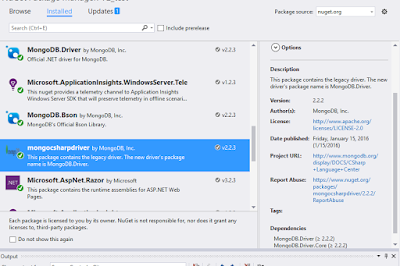Let's start and check the latest MongoDb Driver for C# (Mongo V2).
If you are not still configured your Mongo Server yet. see this Post
If you need some guide on old MongoDb Driver V1. See this Post
New Features In V2
Here is the Db Structure and Sample Data I'm going to Use
DB Structure : Create Collection in Mongo Server With name of Students
Here is some sample Json Data for Students Collection
/* 1 */
{
"_id" : ObjectId("56c3206ddaa3d39f5a130bcc"),
"StudentId" : 1,
"Name" : "Saman kumara",
"Address" : "Sample"
}
/* 2 */
{
"_id" : ObjectId("56c69ed3926ffb2c80ed00bb"),
"StudentId" : 2,
"Name" : "Piyal kumara",
"Address" : "adadasd"
}
1. Create New MVC Website from Visual Studio
2. Add New Class to the models called Student
4. Create ConnetcionString and Database Variables for mongodb by R-click on Project -> Properties -> Settings Add relevant values of variables.
5. Create DbContext Class MongoDbContext
Get data From Mongo
1. Add following code to the HomeController
Create Private property of Context and initialize it
2. Edit The View as following
3. Run and see the result ..
Add Documents
Here is sample async code for insert element to the Mongo Context
Filter Elements
Update Or Replace Element
Delete element
Full code In Git ..
Enjoy Coding
If you are not still configured your Mongo Server yet. see this Post
If you need some guide on old MongoDb Driver V1. See this Post
New Features In V2
- Async Support
- Method Naming convention with helpful names ( SelectOne, InsertOne etc)
- Legacy API Support
Here is the Db Structure and Sample Data I'm going to Use
DB Structure : Create Collection in Mongo Server With name of Students
Here is some sample Json Data for Students Collection
/* 1 */
{
"_id" : ObjectId("56c3206ddaa3d39f5a130bcc"),
"StudentId" : 1,
"Name" : "Saman kumara",
"Address" : "Sample"
}
/* 2 */
{
"_id" : ObjectId("56c69ed3926ffb2c80ed00bb"),
"StudentId" : 2,
"Name" : "Piyal kumara",
"Address" : "adadasd"
}
1. Create New MVC Website from Visual Studio
2. Add New Class to the models called Student
public class Student { [BsonRepresentation(BsonType.ObjectId)] public string Id { get; set; } public int StudentId { get; set; } public string Name { get; set; } public string Address { get; set; } }
3. Install MongoCsharpDriver Nuget package from the Nuget
4. Create ConnetcionString and Database Variables for mongodb by R-click on Project -> Properties -> Settings Add relevant values of variables.
5. Create DbContext Class MongoDbContext
public class MongoDbContext { public IMongoDatabase Database; public MongoDbContext() { var client = new MongoClient(Settings.Default.ConnectionString); Database = client.GetDatabase(Settings.Default.Database); } public IMongoCollection<Student> Students { get { return Database.GetCollection<Student>("Students"); } } }
Get data From Mongo
1. Add following code to the HomeController
Create Private property of Context and initialize it
private MongoDbContext _context { get; set; } public HomeController() { _context = new MongoDbContext(); } // GET: Home public ActionResult Index() { //Get Data from Db ViewBag.Data = _context.Students.AsQueryable().Select(a=>new Student { Name=a.Name,Address=a.Address ,StudentId=a.StudentId}).ToList(); return View(); }
2. Edit The View as following
@{ ViewBag.Title = "Index"; } <h2>Index</h2> @Html.ActionLink("Create", "Create") <table class="table"> <tr> <th> Student Id </th> <th> Name </th> <th> Address </th> <th> </th> </tr> @foreach (var stu in ViewBag.Data) { <tr> <td> @stu.StudentId </td> <td> @stu.Name </td> <td> @stu.Address </td> <td> @Html.ActionLink("Edit", "Edit", new { id = @stu.StudentId }) | @Html.ActionLink("Delete", "Delete", new { id = @stu.StudentId }) </td> </tr> } </table>
3. Run and see the result ..
Add Documents
Here is sample async code for insert element to the Mongo Context
[HttpPost] [ValidateAntiForgeryToken] public async Task<ActionResult> Create([Bind(Include = "StudentId,Name,Address")] Student student) { try { //Insert one item await _context.Students.InsertOneAsync(student); return View(); } catch (Exception) { return View(student); } }
Filter Elements
private Student GetStudent(int id) { //Filter element var std = _context.Students .Find(r => r.StudentId == id) .FirstOrDefault(); return std; }
Update Or Replace Element
[HttpPost] [ValidateAntiForgeryToken] public async Task<ActionResult> Edit([Bind(Include = "id,StudentId,Name,Address")] Student student) { //Full update /replace // await _context.Students.ReplaceOneAsync(r => r.StudentId == student.StudentId, student); //Partial Update var update = Builders<Student>.Update.Set(s => s.Name, student.Name); await _context.Students.UpdateOneAsync(r => r.StudentId == student.StudentId, update); return RedirectToAction("index"); }
Delete element
public async Task<ActionResult> Delete(int id) { //Delete element await _context.Students.DeleteOneAsync(s=> s.StudentId==id); return RedirectToAction("index"); }
Full code In Git ..
Enjoy Coding




















